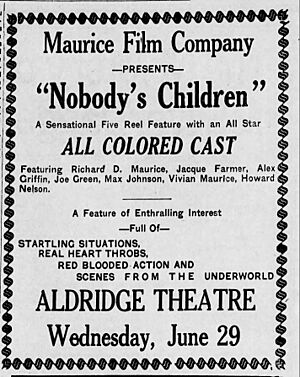Richard D. Maurice facts for kids
Quick facts for kids
Richard D. Maurice
|
|
|---|---|

Richard D. Maurice in a scene from the film "Eleven P.M."
|
|
| Born | June 14, 1893 |
| Died | February 5, 1955 (aged 61) |
| Occupation | Film director, union organizer |
|
Notable work
|
Eleven P.M. |
| Spouse(s) | Vivian Irene "Birdie I." Madison |
| Children | Richard D. Maurice, Jr. Wanda Irene Maurice |
Richard D. Maurice (born June 14, 1893 – died February 5, 1955) was a very important filmmaker during the time of silent films. These were movies without spoken dialogue. Later, he also helped start a union for dining car workers. He was of African descent.
Early Life
Richard Danal Maurice was born in Matanzas, Cuba, on June 14, 1893. In 1903, when he was about 10 years old, Maurice moved to the United States. He lived in Detroit, where he owned a tailor's shop.
Film Career
In July 1920, Richard Maurice started his own company called the Maurice Film Company. Its main office was in Detroit. This company made two feature films, which are longer movies.
The first film, Nobody's Children, came out in September 1920. It was shown in many places in the eastern United States. Even though we know a lot about when and where it was shown, sadly, no copies of the film exist today.
Maurice's second film was Eleven P.M.. We don't know as much about when it was first shown, but it's usually thought to be from 1928. Some experts believe it might have been finished a bit later, around 1929 or 1930. This movie is special because it's the only one of Maurice's films that we still have today. Historians have called Eleven P.M. one of the best Black films from the silent movie era. They also praise Maurice for his creative ways of filming, like using different camera angles and special effects.
Richard Maurice continued to work in the movie industry until the early 1930s. By 1936, he was living in New York City.
Helping Workers
In 1940, Maurice started working as a waiter on dining cars for the Atlantic Coast Line Railroad in New York City. A few years later, he moved to the New York Central Railroad. While working there, he helped create a union called the Dining Car and Railroad Food Workers union, Local 370. This union helped workers have a stronger voice and better working conditions.
Later, in 1946, Maurice had some disagreements with the union's leaders. He felt they were not doing enough to help the regular workers. He even wrote an article in a newspaper, sharing his concerns.
Richard Maurice passed away in New York City on February 5, 1955.
Filmography
- Nobody's Children (1920)
- Home Brew (1920) [short film]
- Eleven P.M. (1928)
Legacy
In 2020, a historical group planned to show Eleven P.M. and have a discussion about it. However, this event had to be postponed because of the Covid epidemic.


